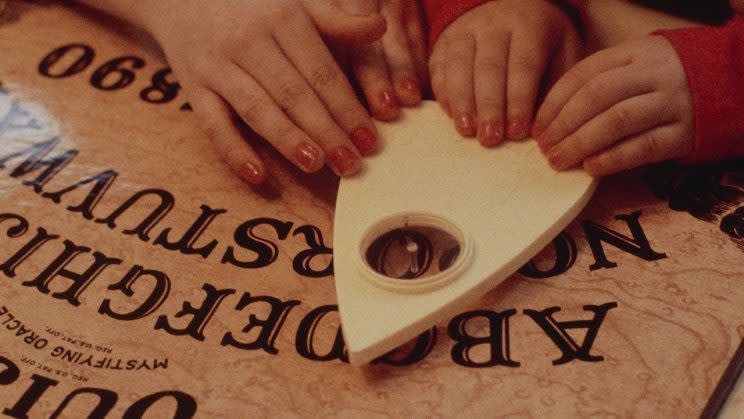A Ouija Board Expert Explains How the Fun-Loving Family Game Became a Horror Movie Staple

The new movie Ouija: Origin of Evil, the well-reviewed prequel to 2014’s micro-budget horror hit Ouija, is the latest film to explore the dangers of communicating with the spirit world through a plastic planchette. But the Ouija board wasn’t always the stuff of cinematic nightmares. Before The Exorcist and Paranormal Activity established the Ouija board as demonic transcription service, it was seen as a fun activity for families or couples who were curious about the unknown. How did the Ouija board become the go-to horror movie prop it is today? To find out, Yahoo Movies took a deep dive into the history of the Ouija board with help from Joseph Laycock, assistant professor of religious studies at Texas State University and author of Dangerous Games: What the Moral Panic Over Role-Playing Games Says about Play, Religion, and Imagined Worlds.
Related: The Real Stories Behind All Those Exorcism Movies
The Ouija board originated with Spiritualism, a 19th century religious movement based on the idea that people in the living world can communicate with and learn from the spirits of the dead. “Spiritualists were really positive, joyful people,” Laycock says of the mediums and believers who laid the groundwork for the Ouija board. Spiritualists supposedly communicated with the dead via séances, which became a popular form of entertainment in the United States — particularly in the years following the Civil War, when many people wished to hear from loved ones who died in battle. But communication was slow; to receive messages, mediums would call out letters of the alphabet and wait for the ghost to “respond” to each one. “If you just stop and think about how ponderous that would have been,” says Laycock. “’Spirit, what is your name? ‘A-B-C-D-Stop. Okay, we’ve got a D!’… Brandon Hodge, who’s a historian of these things, has figured out that in 90 minutes, you could basically get the equivalent of a tweet from the spirit.”
Watch a trailer for ‘Ouija: Origin of Evil:’
The planchette and the alphabet board evolved as a way to speed up those supernatural conversations. “Talking boards,” nicknamed “Ouija boards” by a Chicago toy company in 1890, quickly became a mainstream form of entertainment. The board’s early film appearances include a whimsical 1920 cartoon by Max Fleischer and the 1944 haunted-house romance The Uninvited. In 1966, Parker Brothers began manufacturing its version of the Ouija board, and it was so popular that they immediately doubled production; the following year, more people bought Ouija than Monopoly. (It’s no coincidence that Ouija: Origin of Evil is set in 1967.) And though the boards were regarded with suspicion by some — including Pope Pius X, who warned American Catholics against owning a Ouija board in 1919 — their most scandalous aspect was that they required men and women to sit next to each other in the dark. (“That’s an aspect that’s kind of been forgotten about — the romantic element to playing the Ouija board,” says Laycock). In general, the boards were considered a pretty innocent pastime, akin to fortune telling or astrology.

That is, until The Exorcist came along. The 1973 horror film — inspired by an allegedly true story — was a huge blockbuster that ignited a national obsession with demonic possession. Early in the film, the soon-to-be-victim Regan (a 12-year-old girl played by Linda Blair) says that she uses a Ouija board to communicate with someone named “Captain Howdy” — presumably an alias for the demon who will take over her body. (Watch the clip below.) Thereafter, the Ouija board became seen not just as way to speak with the dead, but as a conduit for evil forces.
Regan (Linda Blair) tells her mother (Ellen Burstyn) about using the Ouija board to talk to “Captain Howdy” in a scene from ‘The Exorcist.’
Once it was viewed as a tool of the devil, the Ouija board became a standard horror-movie gimmick, appearing in films like Amityville 3-D (1983), the Witchboard trilogy (1985-1995), and What Lies Beneath (2000). Then in 2007, the Ouija board experienced a Travolta-like Hollywood comeback, thanks to a memorable role in the found-footage mega-hit Paranormal Activity. According to the website OujiaBoardMovies.com, more than 40 Ouija-themed films have been produced since 2000, most of which fall into the low-budget horror category.
Related: ‘The Amityville Horror’ House and Other Famous Scary Movie Homes for Sale
To explain this trend, Laycock draws a comparison to another horror movie staple: Ed and Lorraine Warren, the paranormal experts whose work inspired The Amityville Horror, the Conjuring movies, and Annabelle. “Part of what [the Warrens] are doing is convincing you that ordinary household things are demonic,” Laycock explains. “If you see the original Annabelle in the Warrens’ museum, it’s not some spooky 100-year-old doll. It’s a Raggedy Ann doll from K-Mart, but they have kind of imbued it with this mythic narrative. So I think that was part of what happened: After The Exorcist, there was a demand for these kinds of encounters with the supernatural, and the Ouija board was something that people could latch onto.”
Ouija boards will continue to scare audiences, as long as those audiences harbor the slightest notion that slow-spelling ghosts might be real. “Horror movies are effective when they play with things that the audience half-believes in,” Laycock says. “[Filmmakers] today are smarter, and they’re trying to play with the audience’s own belief and doubts, trying to hit that spot where you’re not sure if this could really happen or not. And that’s what makes it creepy.”
Related: Ouija Before ‘Ouija’: 6 Movie Moments Featuring the Spooky Spirit Board


